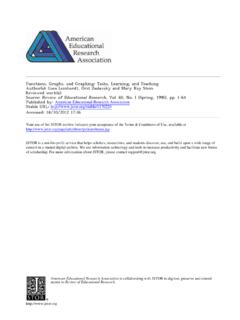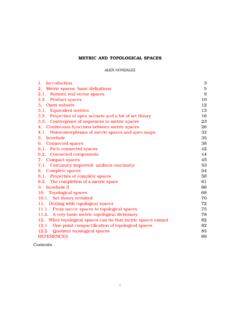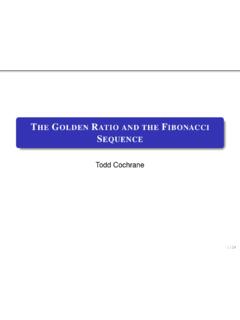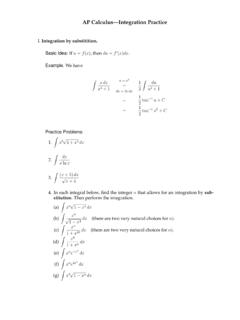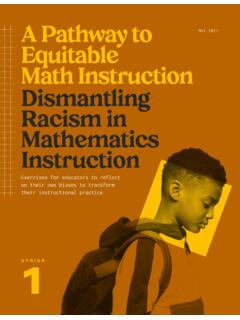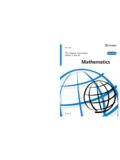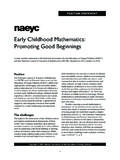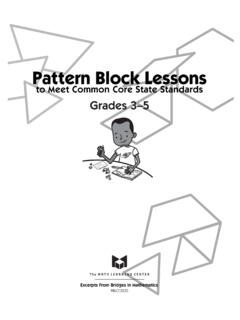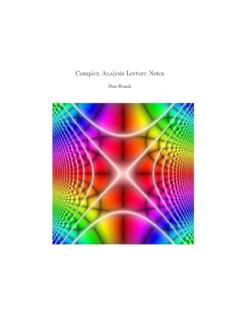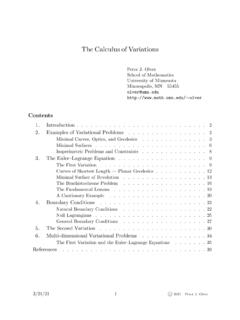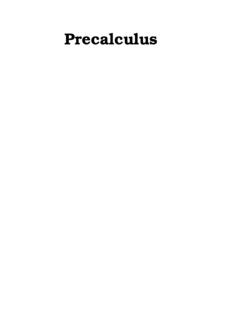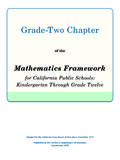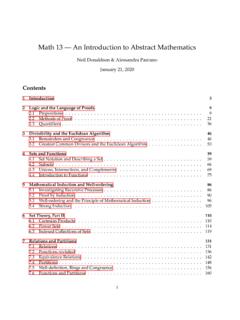Transcription of Advanced High-School Mathematics - math.ksu.edu
1 Advanced High-School MathematicsDavid B. SurowskiShanghai American SchoolSingapore American SchoolJanuary 29, 2011iPreface/AcknowledgmentThe present expanded set of notes initially grew out of an attempt toflesh out the International Baccalaureate (IB) Mathematics FurtherMathematics curriculum, all in preparation for my teaching this dur-ing during the AY 2007 2008 school year. Such a course is offered onlyunder special circumstances and is typically reserved for those rare stu-dents who have finished their second year of IB Mathematics HL intheir junior year and need a capstone Mathematics course in theirsenior year. During the above school year I had two such IB math - ematics students. However, feeling that a few more students wouldmake for a more robust learning environment, I recruited several of my2006 2007 AP Calculus (BC) students to partake of this rare offeringresulting.
2 The result was one of the most singular experiences I ve hadin my nearly 40-year teaching career: the brain power represented inthis class of 11 blue-chip students surely rivaled that of any assemblageof High-School students anywhere and at any time!After having already finished the first draft of these notes I becameaware that there was already a book in print which gave adequatecoverage of the IB syllabus, namely the Haese and Harris text1whichcovered the four IB Mathematics HL option topics, together with achapter on the retired option topic on Euclidean geometry. This is avery worthy text and had I initially known of its existence, I probablywouldn t have undertaken the writing of the present notes. However, astime passed, and I became more aware of the many differences betweenmine and the HH text s views on High-School Mathematics , I decidedthat there might be some value in trying to codify my own personalexperiences into an Advanced Mathematics textbook accessible by andinteresting to a relatively Advanced High-School student, without beingconstrained by the idiosyncracies of the formal IB Further Mathematicscurriculum.
3 This allowed me to freely draw from my experiences first asa research mathematician and then as an AP/IB teacher to weave someof my all-time favorite mathematical threads into the general narrative,thereby giving me (and, I hope, the students) better emotional and1 Peter Blythe, Peter Joseph, Paul Urban, David Martin, Robert Haese, and Michael Haese, Mathematics for the international student; Mathematics HL (Options), Haese andHarris Publications, 2005, Adelaide, ISBN 1 876543 33 7iiPreface/Acknowledgmentintellectual rapport with the contents. I can only hope that the readers(if any) can find some something of value by the reading of my stream-of-consciousness basic layout of my notes originally was constrained to the fiveoption themes of IB: geometry, discrete Mathematics , abstract alge-bra, series and ordinary differential equations, and inferential , I have since added a short chapter on inequalities and con-strained extrema as they amplify and extend themes typically visitedin a standard course in Algebra II.
4 As for the IB option themes, myorganization differs substantially from that of the HH text. Theirs isone in which the chapters are independent of each other, having verylittle articulation among the chapters. This makes their text especiallysuitable for the teaching of any given option topic within the contextof IB Mathematics HL. Mine, on the other hand, tries to bring outthe strong interdependencies among the chapters. For example, theHH text places the chapter on abstract algebra (Sets, Relations, andGroups) before discrete Mathematics (Number Theory and Graph The-ory), whereas I feel that the correct sequence is the other way of the motivation for abstract algebra can be found in a varietyof topics from both number theory and graph theory. As a result, thereader will find that my Abstract Algebra chapter draws heavily fromboth of these topics for important examples and another important example, HH places Statistics well before Se-ries and Differential Equations.
5 This can be done, of course (they didit!), but there s something missing in inferential statistics (even at theelementary level) if there isn t a healthy reliance on analysis. In my or-ganization, this chapter (the longest one!) is the very last chapter andimmediately follows the chapter on Series and Differential made more natural, for example, an insertion of a theoreticalsubsection wherein the density of two independent continuous randomvariables is derived as the convolution of the individual densities. Asecond, and perhaps more relevant example involves a short treatmenton the random harmonic series, which dovetails very well with thealready-understood discussions on convergence of infinite series. Thecute fact, of course, is that the random harmonic series converges withprobability would like to acknowledge the software used in the preparation ofthese notes.
6 First of all, the typesetting itself made use of the indus-try standard, LATEX, written by Donald Knuth. Next, I made use ofthree different graphics resources:Geometer s Sketchpad,Autograph,and the statistical workhorseMinitab. Not surprisingly, in the chapteron Advanced Euclidean Geometry, the vast majority of the graphicswas generated through Geometer s Sketchpad. I like Autograph as ageneral-purpose graphics software and have made rather liberal use ofthis throughout these notes, especially in the chapters on series anddifferential equations and inferential statistics. Minitab was used pri-marily in the chapter on Inferential Statistics, and the graphical outputsgreatly enhanced the exposition. Finally, all of the graphics were con-verted to PDF format via ADOBER ACROBATR 8 PROFESSIONAL(version ). I owe a great debt to those involved in the productionof the above-mentioned that I have already posted these notes to the internet, Iwould appreciate comments, corrections, and suggestions for improve-ments from interested colleagues and students alike.
7 The present ver-sion still contains many rough edges, and I m soliciting help from thewider community to help identify , my greatest debt ofgratitude is to the eleven students(shown to the right) I conscriptedfor the class. They are (back row):Eric Zhang (Harvey Mudd), Jong-Bin Lim (University of Illinois),Tiimothy Sun (Columbia Univer-sity), David Xu (Brown Univer-sity), Kevin Yeh (UC Berkeley),Jeremy Liu (University of Vir-ginia); (front row): Jong-Min Choi (Stanford University), Young(Duke University), Nicole Wong (UC Berkeley), Emily Yeh (Universityof Chicago), and Jong Fang (Washington University). Besides provid-ing one of the most stimulating teaching environments I ve enjoyed overivmy 40-year career, these students pointed out countless errors in thisdocument s original draft. To them I owe an un-repayable list of acknowledgements would be woefully incomplete withoutspecial mention of my life-long friend and colleague, Professor RobertBurckel, who over the decades has exerted tremendous influence on howI view SurowskiEmeritus Professor of MathematicsMay 25, 2008 Shanghai, draft: April 6, 2007 Second draft: June 24, 2007 Third draft: August 2, 2007 Fourth draft: August 13, 2007 Fifth draft: December 25, 2007 Sixth draft: May 25, 2008 Seventh draft: December 27, 2009 Eighth draft: February 5, 2010 Ninth draft: April 4, 2010 Contents1 Advanced Euclidean Role of Euclidean Geometry in High-School Triangle Geometry.
8 Notations .. Pythagorean theorem .. Sensed magnitudes; The Ceva and Menelaustheorems .. of the Ceva and Menelaus theorems interlude: laws of sines and cosines .. results; Stewart s theorem and Apollo-nius theorem .. Circle Geometry .. angles .. s theorem and the power of a point .. quadrilaterals and Ptolemy s theorem .. Internal and External Divisions; the Harmonic Ratio .. The Nine-Point Circle .. Mass point geometry .. 462 Discrete Elementary Number Theory .. division algorithm .. linear Diophantine equationax+by=c.. Chinese remainder theorem .. and the fundamental theorem of arithmetic Principle of Mathematical Induction .. s and Euler s theorems .. congruences .. number bases .. recurrence relations .. Elementary Graph Theory .. trails and circuits.
9 Cycles and optimization .. and spanning trees .. graphs .. 1343 Inequalities and Constrained A Representative Example .. Classical Unconditional Inequalities .. Jensen s Inequality .. The H older Inequality .. The Discriminant of a Quadratic .. The Discriminant of a Cubic .. The Discriminant (Optional Discussion) .. resultant off(x) andg(x) .. discriminant as a resultant .. special class of trinomials .. 1824 Abstract Basics of Set Theory .. relationships .. operations on subsets of a given set . constructions new sets from old .. between sets .. and equivalence relations .. Basics of Group Theory .. graph automorphisms .. algebra the concept of a binary oper-ation .. of binary operations .. concept of a group .. groups .. s theorem .. and isomorphisms.
10 To the motivation .. 2405 Series and Differential Quick Survey of Limits .. definitions .. integrals .. forms and l H opital s rule .. Numerical Series .. of non-negative term for convergence of non-negative term series and absolute convergence; alternat-ing series .. Dirichlet test for convergence (optional dis-cussion) .. The Concept of a Power Series .. and interval of convergence .. Polynomial Approximations; Maclaurin and Taylor Ex-pansions .. and tricks .. analysis and Taylor s theorem .. Differential Equations .. fields .. and homogeneous first-order ODE .. first-order ODE; integrating factors .. s method .. 3146 Inferential Discrete Random Variables .. , variance, and their properties .. law of large numbers (optional discussion) . random harmonic series (optional discussion) geometric distribution.
